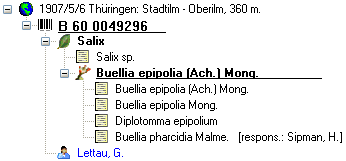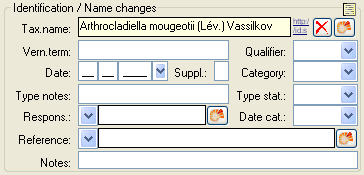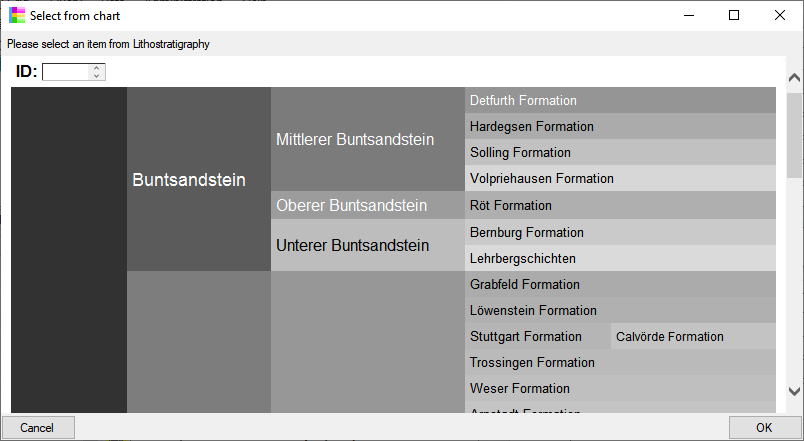 icon. The last identification will always be taken as the valid
one
and set at the top of the list. To insert an older
identification at the base of the list click
on the
icon. The last identification will always be taken as the valid
one
and set at the top of the list. To insert an older
identification at the base of the list click
on the  icon.
icon.Each organism or unit
may have been identified
several times. The identifications
are listed in the tree under the organism as
shown in the image below. To create a new identification choose
the organism from
the tree and click on the
 icon. The last identification will always be taken as the valid
one
and set at the top of the list. To insert an older
identification at the base of the list click
on the
icon. The last identification will always be taken as the valid
one
and set at the top of the list. To insert an older
identification at the base of the list click
on the  icon.
icon.

To hide / show the
identifications in the tree
click on the
 icon on the right panel next to the tree. To enter a
confirmation of an identification
choose it in the tree and then click on the
icon on the right panel next to the tree. To enter a
confirmation of an identification
choose it in the tree and then click on the
 button. To move an identification to the end or the start of the
list use the
button. To move an identification to the end or the start of the
list use the
 or
or
 button respectively. To delete an identification select it in
the tree and click
the
button respectively. To delete an identification select it in
the tree and click
the  button.
To enter details for an identification choose it in the tree.
You can then enter
the details in the form opening on the right side of the tree as
shown below.
button.
To enter details for an identification choose it in the tree.
You can then enter
the details in the form opening on the right side of the tree as
shown below.

The taxonomic name of an
organism can be selected from
either the names already available in
DiversityCollection or from the module
DiversityTaxonNames. To choose from the
local names type the beginning of
the name and click on the drop-down
button  to get a list of available names. You
can use wildcards
according to SQL.
to get a list of available names. You
can use wildcards
according to SQL.
To select a taxonomic name
from an external database
click on the  button.
A
window will open where you can search
for a taxonomic name. For taxonomic names provided by the module DiversityTaxonNames you can use a
shortcut. Click on the
button.
A
window will open where you can search
for a taxonomic name. For taxonomic names provided by the module DiversityTaxonNames you can use a
shortcut. Click on the
 button to set the source in the window
that will open. After the source is set, the pin
button to set the source in the window
that will open. After the source is set, the pin
 and drop-down box will change their colors
as shown below to indicate that the taxonomic names are not longer derived from
the content in DiversityCollection but from the selected DiversityTaxonNames
database.
and drop-down box will change their colors
as shown below to indicate that the taxonomic names are not longer derived from
the content in DiversityCollection but from the selected DiversityTaxonNames
database.

The links will be set separate for every taxonomic
group and may be changed at any time with a click on the
 button. To release the link to the remote
database, click on the
button. To release the link to the remote
database, click on the  button and than select Cancel in the window
where you select the database. The pin will change to
button and than select Cancel in the window
where you select the database. The pin will change to
 and the data will again be derived from
the local values in DiversityCollection.
and the data will again be derived from
the local values in DiversityCollection.
For identifications linked to a DiversityTaxonNames database you may activate the Show accepted names option. Accepted names will then be shown with a green color while for synonyms the accepted name will be displayed above the current name (see below).

Non biological units like
 soil,
soil,
 rock or
rock or
 mineral do not have biology related
information like a qualifier or a type status. These are therefore not
displayed for these groups. Furthermore the source for the names is not
DiversityTaxonNames but DiversityScientificTerms (see a short tutorial
mineral do not have biology related
information like a qualifier or a type status. These are therefore not
displayed for these groups. Furthermore the source for the names is not
DiversityTaxonNames but DiversityScientificTerms (see a short tutorial 
 ).
If the source for a non biological unit is set to a
DiversityScientificTerms database (see above
).
If the source for a non biological unit is set to a
DiversityScientificTerms database (see above
 ) a
) a
 button will appear. With a click on this button you can
select the term from a chart as shown below.
button will appear. With a click on this button you can
select the term from a chart as shown below.

In the database the data for the identification is stored in the table Identification.